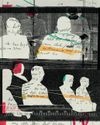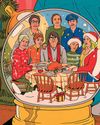
Demanding that your friend pull the car over so you can examine an unusual architectural detail is not, I’m told, endearing. But some of us cant help ourselves. For the painter Grant Wood, it was an incongruous Gothic window on an otherwise modest frame house in Eldon, Iowa, that required stopping. It looked as if a cottage were impersonating a cathedral. Wood tried to imagine who would fit into such a home.” He recruited his sister and his dentist as models and costumed them in old-fashioned attire. The result, American Gothic,” as he titled the painting from 1930, is probably the most famous art work ever produced in the United States. The painting was also decidedly enigmatic. Was it biting satire? Grim realism? Proud patriotism? In the words of the late Thomas Hoving, a longtime director of the Metropolitan Museum of Art, the image served as a Rorschach test for the character of the nation.”
For Wood, however, the meaning was clear. Although he faced "a storm of protest from Iowa farm wives’—one threatened to "smash my head,” he recalled— he had painted "American Gothic” with sympathy. Cities dominated culture, he wrote, yet they were far less typically American” than the rural places "whose power they usurped.” In 1935, Wood, who was born on an Iowa farm forty-four years earlier, published the manifesto "Revolt Against the City.”
この記事は The New Yorker の October 23, 2023 版に掲載されています。
7 日間の Magzter GOLD 無料トライアルを開始して、何千もの厳選されたプレミアム ストーリー、9,000 以上の雑誌や新聞にアクセスしてください。
すでに購読者です ? サインイン
この記事は The New Yorker の October 23, 2023 版に掲載されています。
7 日間の Magzter GOLD 無料トライアルを開始して、何千もの厳選されたプレミアム ストーリー、9,000 以上の雑誌や新聞にアクセスしてください。
すでに購読者です? サインイン

GET IT TOGETHER
In the beginning was the mob, and the mob was bad. In Gibbon’s 1776 “Decline and Fall of the Roman Empire,” the Roman mob makes regular appearances, usually at the instigation of a demagogue, loudly demanding to be placated with free food and entertainment (“bread and circuses”), and, though they don’t get to rule, they sometimes get to choose who will.

GAINING CONTROL
The frenemies who fought to bring contraception to this country.

REBELS WITH A CAUSE
In the new FX/Hulu series “Say Nothing,” life as an armed revolutionary during the Troubles has—at least at first—an air of glamour.

AGAINST THE CURRENT
\"Give Me Carmelita Tropicana!,\" at Soho Rep, and \"Gatz,\" at the Public.

METAMORPHOSIS
The director Marielle Heller explores the feral side of child rearing.

THE BIG SPIN
A district attorney's office investigates how its prosecutors picked death-penalty juries.

THIS ELECTION JUST PROVES WHAT I ALREADY BELIEVED
I hate to say I told you so, but here we are. Kamala Harris’s loss will go down in history as a catastrophe that could have easily been avoided if more people had thought whatever I happen to think.

HOLD YOUR TONGUE
Can the world's most populous country protect its languages?

A LONG WAY HOME
Ordinarily, I hate staying at someone's house, but when Hugh and I visited his friend Mary in Maine we had no other choice.

YULE RULES
“Christmas Eve in Miller’s Point.”